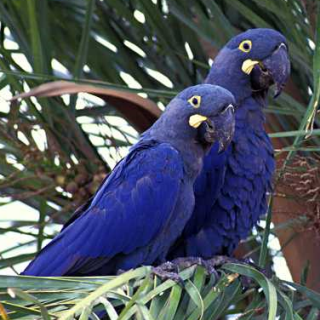Project Regions:
Lear’s Macaw |
|
|
Collaborators/Funders
BioBrasil Foundation, Wildlife Conservation Society (partner) Museu de Zoologia Universidade de Sao Paulo, BioBrasil, Natural Encounters, Inc., Paradise Park, Disney Worldwide Conservation Fund, Keith Ewart Foundation, People’s Trust for Endangered Species, Barbara Delano Foundation
Rare macaw's world population at over 1600 individuals
The Lear's Macaw (Anodorhynchus leari) is listed as Endangered in the wild, threatened by habitat loss, hunting, and the wild bird trade.
Progress and outcomes: Historically, WPT supported the work of the BioBrasil Foundation in NE Brazil, where they worked on calculating population size, monitoring recovery, and detecting potential problems such as low juvenile survival.
Focus of future work: In 2010 the Trust began funding biologist Erica Pacifico's work in Lear’s reproductive biology at the species' second-largest roosting and breeding ground at Canudos Biological Station in Minas Gerais, Brazil. This ground-breaking work has documented:
- Numbers of fertile eggs
- Studies on bird movement and nestling survival
- Quantifying and resolving the threat of invasive Africanised bees on chicks and adults
- Disease sampling
- Determining the sex ratio of the population
- Analysis of foodstuffs and their availability
- Monitoring recovery of populations
- Searching for new breeding sites
- Creation of a monitored release site for captive-bred macaws
In 2016 the project team discovered that the macaws had returned to a historical breeding site after an absence of four decades. In 2017, the team completed its 10th season of fieldwork with its 30th expedition. The researchers also found that local people are becoming more interested in the conservation of the macaws. Recently, pending wind farms, poaching related to honey-hunting and increasing powerline collisions were deemed to be threats.
With your help we can complete these important tasks to better understand the species, and continue to deliver effective solutions to further their conservation.
Wild population: Over 1600 (2018)
Where found: Confined to the Raso da Catarina plateau, NE Bahia, Brazil.
History: The Lear’s Macaw or Anodorhynchus leari, is found in two colonies at Toca Velha and Serra Branca, south of the Raso da Catarina plateau in NE Bahia, Brazil. By 1983, the global population was reduced to just 60 birds (Yamashita 1987). Since then surveys have counted 246 birds in 2001 (Gilardi 2001), 400-500 in 2004, 630 in 2006 (Y. Barros in litt. 2007), 960 in 2008 (P. Develey in litt. 2009) and 1,123 in 2010 (Barbosa 2010). These figures are likely to include a large percentage of sub-adults (J. Gilardi in litt. 2007). Dividing and recording adults from juveniles in the field is difficult for this species as juvenile birds have been known to pair up and behave like nesting birds before actually attempting to mate (J. Gilardi in litt. 2007). Some of the population increase may reflect changes in methodology and survey effort (J. Gilardi in litt. 2007). The population has also increased due to intensive conservation efforts.
Threats:
- Trapping for wild bird trade, although now reduced
- Reduction in wild Licuri palm stands due to livestock grazing
- Threat of fire wiping out habitat
- Persecution as crop pest
- Hunting for food and wildlife products
Ecology: Lear’s Macaw populations are confined to the Raso da Catarina plateau, NE Bahia, Brazil. This species makes its home in dry, rugged caatinga (thorn scrub) terrain, mostly in areas with Syagrus coronata palms. Its staple food item is Syagrus palm nuts, but fruits, agave flowers and maize are also taken. Liquid from unripe palm fruit is thought to be a major source of moisture. Lear's Macaws are gregarious and usually seen in flocks. They roost communally in weathered crevices near the tops of sandstone ravines. When departing for the day they leave in groups to fly, foraging before dawn and returning at dusk.
Project Updates
- PsittaScene Winter 2020
- PsittaScene Vol. 29.1 Spring 2017
- PsittaScene Vol. 24.1, Feb. 2012
- PsittaScene Vol. 24.4, Nov. 2010
- PsittaScene Vol. 17.2, May 2005
- PsittaScene Vol. 15.1, Feb. 2003
- PsittaScene Vol. 13.3, Aug. 2001
- PsittaScene Vol. 13.1, Feb. 2001
- PsittaScene Vol. 10.4, Nov. 1998
WPT-sponsored research:
Other publications:
Google scholar - Anodorhynchus leari


































